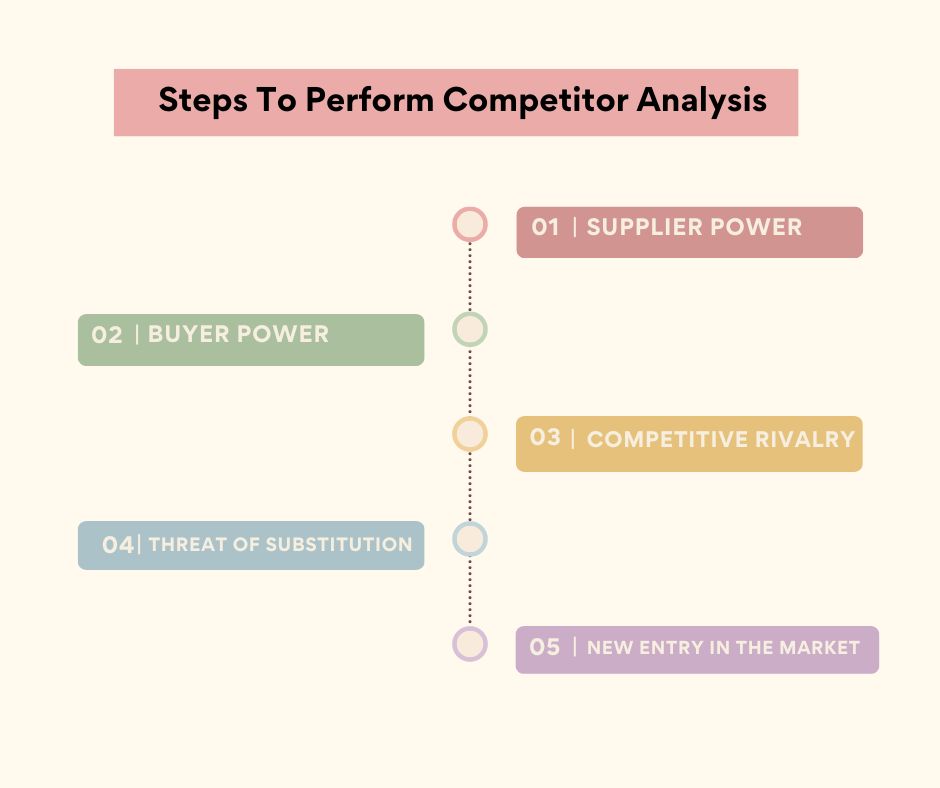If you want to make it in the digital world, you’ve got to do your homework – know what’s needed, who your competitors are, and what your weaknesses and strong points are. That’ll help you build up an edge and keep growing. This article is all about helping folks understand the concept of competitive analysis in digital marketing, its advantages, and when to put it into action. Plus, we’ll be guiding you through the key aspects of mastering competitive analysis so that you can make the most out of it.
What is Competitive Analysis?
Checking out your competition is one way to get ahead – it involves researching both direct and indirect competitors and figuring out how they compare to you. You can assess their strengths and weaknesses in comparison to yours. Doing a competitive analysis can give you insight into your market, such as what customers like, their buying behavior, and tastes. This info can show you options to help your business grow, strategies to neutralize competition and help fine-tune your marketing.
When Do I Need to Do a Competitive Analysis?
Before jumping into a website project or any branding endeavors, you need to conduct both feasibility and competition assessment. Doing this is essential because it can give you an idea of what your digital audience wants and who your rivals are.
Putting in the time for competitive analysis is key. Staying up to date with market changes isn’t something that can be done just once and forgotten about. No, it’s an ongoing process that requires a lot of attention.
Read about : Characteristics Of A Scalable Business
The Importance of Competitor Analysis
It’s a tough job trying to stay afloat in a highly-competitive sector. To succeed, it’s essential to make the right strategic moves and use effective marketing techniques. Doing the following things can and will definitely help you stay ahead of the game:
- To review benchmarks: Keeping tabs on your own analytics gives you a good idea of what’s working – but if your competitors are doing even better, it’s essential to find out.
- In order to stay on top of industry and market trends: Each year, there are certain seasonal trends that come and go. Keep an eye on the competition if you want to be prepared when demand spikes or dips.
- It helps you to get an idea of what new practices to use & what mistakes to steer clear of: Trying new channels can be a huge waste of money, so it’s often smarter to let your rivals go first and learn from their mistakes. This way, you don’t have to risk your own budget in the process.
- It gives your marketing mix a makeover: Keeping tabs on the competition is an important part of staying ahead in the digital marketing game. By checking out your competitors’ campaigns, you can stay up to date on the hottest and latest trends and keep a finger on the pulse of what’s going on in the market. You can use this to stay up-to-date on when companies release new products and know how to make the most of those opportunities.
- It fine-tunes your goals: It’s important to be flexible when creating a business strategy. As the market and environment change, so too should your objectives. If you find yourself needing to adjust your strategy or objectives, take the time to review what is working and also what isn’t so you can adjust accordingly.
How To Do Competitor Analysis
Follow the six 6 steps for a thorough analysis of your digital marketing strategies and activities.
This will help you spot your pros and cons, available opportunities, and potential risks.
1. Identify Who Your Competitors Are:
Before taking any steps, you should identify who your direct and indirect competitors are. Your direct competitors offer pretty much the same stuff as you, and your indirect rivals focus on totally different products and services but still attract the same customers.
2. Split Competitors into Two Groups:
Once you’ve identified potential rivals, it’s a good idea to put them into two different categories based on your current capacity and size. The first one is brands that already rival you, and the second would be those that could be competitors as your business grows in the future.
Read about: Ultimate Guide To “Businesses Owned By Amazon
3. Identify the Products Your Competitors Offer:
It’s really important to keep track of what your competitors are up to be aware of the type of competition they provide, the prices they offer, how much market share they hold, and also their keyword rankings. Know that getting familiar with a company’s unique selling points, website, sales strategy, pricing model, and delivery methods is also equally important. That way, you can get a good understanding of how they do business.
4. Find Out Your Competitors’ Tactics:
Take a closer look at your competition’s sales process, customer service options, and marketing efforts across different platforms as they can give you a better understanding of what they’re up to. Want to know what your competitors are up to? You can use tools like SEMRush, Ahrefs, and SimilarWeb. They’ll give you insight into the keywords they’re using, the platforms they have access to, and the campaigns that appear on their site.
5. Do Website Inspection and UX Analysis:
- A bad UX on your website can totally tank your conversion rates, dwell time, and ranking. Make sure to check out the websites of your competitors for ideas on how you can improve. Here’s what to do:
- Decide what you want to achieve from the website check-up.
- Explore your competitor’s pages and see what they are doing well – it might give you some ideas!
- Look into sites that have been doing well lately to get an idea of their strategies and see how you can apply them to boost your rankings.
6. Find the Brand’s Place in the Market (Perceptual Mapping):
Different brands cater to different market needs – for example, pricey and budget-friendly lipsticks can appeal to distinct customer segments. Perceptual mapping based on these features can help you get a better idea of the brand’s positioning. To see where your brand stands in comparison to the competition, figure out which product series they focus on, have a look at the average prices of their products, and see how they’d rank.
7. Determine Strengths and Weaknesses (SWOT Analysis):
Conducting a SWOT analysis can help you recognize the advantages and flaws of your brand. It can also show you brilliant chances in your marketing strategy. Have a look at possible opportunities & risks, and check how they affect your brand’s status in the market.
8. Make an Analysis of the Entire Market (Porter’s 5-Factor Analysis):
Knowing who you’re up against is always critical, but if you take a step back and analyze the industry through Porter’s 5 Factors Analysis, it can give you a clearer picture of your industry.
Read about : how to calculate asset utilization
This method focuses on five main elements:
- New entrants
- Buyers
- Suppliers
- Substitutes
- Competitive rivalry
Looking into each of these can help you to get a clearer understanding of the strength of different forces and your competitors’ place in the market, which will provide you with a better idea about yourself.
Steps to Perform Competitor Analysis:


Porter’s five forces are a must-know when analyzing the competition. It provides a great look into the competitive landscape, so you can spot both strengths and weaknesses in your industry. When you’re trying to make strategic decisions about your product, pricing, marketing, and more, competitor analysis based on Porter’s five forces can be very useful.
- Supplier Power: Suppliers can use their influence to increase wages, materials, and other inputs, which can eventually lead to increased manufacturing costs for companies.
- Buyer Power: People have the ability to influence prices just by changing what they buy. This is known as the bargaining power of customers or buyer power.
- Competitive Rivalry: Rivals in the market drive competition, making it tough for you as you try to beat other businesses for a bigger market share. It’s all about how your product stacks up against your competitors and how everyone’s trying to one-up each other for that extra bit of profit.
- The Threat of Substitution: It’s natural to have a fear that another business or product could take your place, so it’s important for you to stay up-to-date on what other comparable items are out there and how they’re priced. Having a good competitor analysis strategy is key if you want to stay and remain relevant in the market.
- New Entry in The Market: Not only can products be substituted, but new businesses entering the market can pose a threat as well. Easy entry into the industry could result in your business being replaced by rival companies.
Ergo, if you want to stay ahead of the competition, you gotta take all the elements mentioned above into consideration during your market research.
Types of Competitive Analysis
Depending on your business needs, there are a few competitive analysis methods you should be aware of. Here are 3 of the most popular ones:
- PPC Competitor Analysis: Take a closer look at your rivals’ ads and the words they’re bidding on – this will let you drive better outcomes and give you the edge on the competition. Check out their landing pages, too, as they can help you figure out how they’re targeting their customers.
- SEO Competitor Analysis: Keeping an eye on your competition’s SEO activities can be incredibly helpful in discovering areas where you’re lacking. By taking a look at their keywords, website performance, backlinks, and top pages, you can spot avenues to improve your own ranking and drive more people to your website.
- Social Media Competitor Analysis: Keeping up with your competitors’ online presence can be a great way to figure out what platforms your audience is active on, as well as what kind of content they like. Studying their social media presence will help you stay one step ahead. Analyzing customer interactions and engagement on social media can help you identify which type of posts do the best and improve your overall strategy.
Competitor Analysis Tools
Competitor analysis can be made easier with the right tools. Here are some of them:
- Ahrefs: Ahrefs is great for seeing what keywords are working best on any website, plus getting an idea of the amount of traffic it’s bringing in.
- SEMRush: SEMRush is great for getting the scoop on your website’s performance, keeping track of what your rivals are up to in terms of keyword usage, and doing an analysis of backlinks.
- Spyfu: Spyfu digs up your rivals’ most profitable keywords from PPC ads – so you know exactly what to target.
- Similarweb: With Similarweb, you can figure out how much traffic your website and channels are getting, what keywords are trending, and find out data on user engagement.
- Sprout Social: Sprout Social makes it easy to track the growth of your followers, check out how people are engaging with your content, monitor what hashtags are trending, and see how well your ads do.
FREQUENTLY ASKED QUESTIONS:
Believe us when we say that competitive analysis is like a secret weapon that helps you identify who your rivals are and shows you how to outshine them. By keeping tabs on your competition, you’ll know why they’re more successful and why people choose them over you. Plus, armed with this knowledge, you can create something unique that sets your brand apart from the rest!
Absolutely! SWOT analysis is a superhero when it comes to studying your competitors. It helps you figure out what’s working for them, where they could improve, and what their strengths and weaknesses are. With this superpower in your hands, you’ll have the upper hand when it comes to competing against them!
Whoa, hold on there! Skipping competitive analysis could land you in hot water. It’s like wandering blindly without a map in a jungle full of fierce competitors. You could miss out on great opportunities or overlook important factors. Trust us, doing a competitor analysis gives you the inside scoop on their moves and tactics, so it’s definitely worth your while!
Well, it depends on how big your target market is and how deep you want to dive into research. If you’re just checking out your direct competitors, it shouldn’t take more than a couple of hours. But if you want to gather more detailed research like focus groups or customer interviews, then it might take a bit longer.
Absolutely! Even if you’re in a niche market, it’s crucial to do your homework before diving in. You’ve got to make sure there’s enough interest and buying power among your potential customers. Trust us, even small businesses can benefit greatly from competitive research.
The first step in a competitive analysis is – you need to identify who your primary rivals are. These direct rivals are companies that offer the same products to the same customer base you want to reach. Once you know the lay of the land—market, competition, pricing, and marketing strategies—you can find unique ways to stand out and gain an edge!
Read: Spy on Your Competitors in the Digital World
Final Thoughts
There you have it, folks! Competitive analysis is your secret sauce for digital marketing success. It’s like being a detective, uncovering your rivals (both direct and indirect), learning from their successes and failures, and using that knowledge to supercharge your own marketing strategy. And the best part? You get to spy on customer behavior and preferences—talk about an epic market research session!
Remember, staying ahead of the competition is an ongoing adventure. By regularly checking in on your rivals, you’ll stay up to date on industry trends, benchmark your progress, and fine-tune your marketing goals. So gear up, keep an eye on your foes, and let the competitive analysis game begin!




